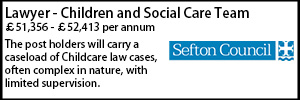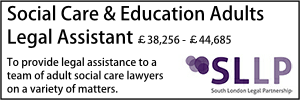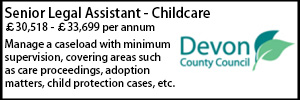The Coronavirus Act 2020 – Adult social care and assessing needs
- Details
Stephen Knafler QC considers the Coronavirus Act 2020 and its far-reaching implications for adult social care.
The framework
The social care provisions are at section 15 and Schedule 12 to the Coronavirus Act 2020 (“the Act”). They came into force in England on the 31 March 2020 (on 1 April, in Wales).
The Act needs to be read together with the statutory guidance, Care Act easements: guidance for local authorities and the non-statutory guidance, Responding to COVID-19: the ethical framework for adult social care.
The duties to assess
The Act has not amended any of the assessment duties found in the Care Act 2014. Instead, paragraph 2 of Schedule 12 to the Act provides that “a local authority does not have to comply with any of the duties imposed by” the assessment provisions in the Care Act 2014, including:
- the duty to assess both an adult’s and a carer’s need for support under sections 9 and 10;
- the duty to comply with the assessment regulations;
- the duty to provide a written copy of an assessment (section 12(3)); and
- the duty to make determinations about eligibility under section 13.
In other words, the duties to assess found in the Care Act 2014 have been converted into, in substance, powers to assess.
However, see below, central government guidance advises local authorities to exercise their powers as if the Care Act 2014 remained in full force and effect, in short, for as long as reasonably practicable.
Bullet points:
- The assessment duties are now, in substance, powers;
- However, local authorities are expected to exercise those powers as if they were duties until it is no longer reasonably practicable to do so.
The duties to meet needs
The Act has amended the duty to meet the eligible needs of adults at section 18 of the Care Act 2014. It has substituted section 18(1), so that section 18 now reads as follows:
18 Duty to meet needs for care and support
(1) A local authority must meet an adult’s needs for care and support if – (a) the adult is ordinarily resident in the authority’s area or is present in its area but of no settled residence; (b) the authority considers that it is necessary to meet those needs for the purpose of avoiding a breach of the adult’s Convention rights; and (c) there is no charge under section 14 for meeting the needs or, in so far as there is, condition 1, 2 or 3 is met.
In this subsection “Convention rights” has the same meaning as in the Human Rights Act 1988.
(2) Condition 1 is met if the local authority is satisfied on the basis of the financial assessment it carried out that the adult’s financial resources are at or below the financial limit.
(3) Condition 2 is met if— (a) the local authority is satisfied on the basis of the financial assessment it carried out that the adult’s financial resources are above the financial limit, but (b) the adult nonetheless asks the authority to meet the adult’s needs.
(4) Condition 3 is met if— (a) the adult lacks capacity to arrange for the provision of care and support, but (b) there is no person authorised to do so under the Mental Capacity Act 2005 or otherwise in a position to do so on the adult’s behalf.
(5) A local authority, having made a determination under section 13(1), must meet the adult’s needs for care and support which meet the eligibility criteria if— (a) the adult is ordinarily resident in the authority’s area or is present in its area but of no settled residence, and (b) the adult’s accrued costs exceed the cap on care costs.
(6) The reference in subsection (1) to there being no charge under section 14 for meeting an adult’s needs for care and support is a reference to there being no such charge because— (a) the authority is prohibited by regulations under section 14 from making such a charge, or (b) the authority is entitled to make such a charge but decides not to do so.
(7) The duties under subsections (1) and (5) do not apply to such of the adult’s needs as are being met by a carer.
The Act made a similar amendment to section 20 of the Care Act 2014, by limiting any duty to meet the needs of a carer to cases where “it is necessary to meet those needs for the purpose of avoiding a breach of the carer’s Convention rights”.
In other words, the duty to meet the care and support needs of adults and carers now only arises when it is necessary to avoid a breach of Convention rights; otherwise, in substance, local authorities have a power to meet the needs of adults and carers.
There is a further proviso. By virtue of paragraph 7(2) of Schedule 12, the Convention duty under section 18(1) or section 20(1) of the Care Act 2014 does not apply if the authority has notified the “relevant person” (as defined) that it may make a charge and they ask the authority not to meet the relevant needs.
Again, however, and see below, central government guidance advises local authorities to exercise their powers as if the Care Act 2014 remained in full force and effect, in short, for as long as reasonably practicable.
Bullet points:
- Duties to meet eligible needs for care and support are now only powers, subject to two Provisos;
- Proviso One, is that local authorities are expected to exercise their power to meet needs, that they would be under a duty to meet but for the Act, for as long as reasonably practicable;
- Proviso Two, is that local authorities remain under a duty always to meet needs where that is necessary in order to avoid a breach of Convention rights (except where the “relevant person” declines services to avoid a financial charge).
Timing of local authority action
As noted above, this part of the Act came into force on the 31 March 2020 (England; the 1 April 2020, Wales).
Paragraph 16 of Schedule 12 to the Act provides that these provisions are fully retrospective.
Paragraph 18 of Schedule to the Act provides however that the Secretary of State may issue guidance, which local authorities “must have regard to”. (Paragraph 18 also allows the Secretary of State to issue directions).
The Secretary of State’s guidance is Care Act easements: guidance for local authorities (“the Guidance”). This advises that local authorities “should comply with the pre-amendment Care Act provisions and related Care and Support Statutory Guidance for as long and as far as possible” (page 4).
This entails a step-by-step approach.
The first line of defence
The Guidance advises that the first step should be using existing flexibilities under the Care Act 2014 to defer utilising the easements for as long as possible.
For example, the Guidance points out that the Care Act 2014 already allows local authorities to assess, review and prioritise in different ways (page 7). For example:
- Paragraph 6.3 of the Care and Support Statutory Guidance advises that while an assessment must always be “appropriate and proportionate” it “may come in different formats and can be carried out in various ways”, including in an appropriate case by an online or telephone process and/or on a “supported self-assessment” basis;
- Section 8 of the Care Act 2014 and paragraph 10.11 of the Care and Support Statutory Guidance make it clear that there is considerable flexibility as to how care needs are met. Thus, Annex A of the Guidance advises that where staff shortages result in a service having to be changed on a short-term basis, that can be done within the parameters of the Care Act 2014 (page 8).
Bullet points:
- What are the flexibilities in the Care Act 2014?;
- How might they be utilised in order to streamline full assessments, decisions about eligibility and support planning to as to maintain a “full service” under the Care Act 2014 for as long as possible?
When is the tipping point reached?
As noted above, the Guidance advises that local authorities “should comply with the pre-amendment Care Act provisions and related Care and Support Statutory Guidance for as long and as far as possible” (page 4).
The Guidance expands on that general approach by advising local authorities to exercise the easements only “when the workforce is significantly depleted, or demand on social care increased, to an extent that it is no longer reasonably practicable for it to comply with its Care Act duties (as they stand prior to amendment by the Coronavirus Act) and where to continue to do so is likely to result in urgent or acute needs not being met, potentially risking life. Any change result from such a decision should be proportionate to the circumstances in a particular Local Authority” (page 5).
Even then, the easements should be used “as narrowly as possible” (page 3).
Bullet points:
- Evidence of steps taken to prevent the “tipping point” being reached locally;
- Evidence that the “tipping point” has been reached locally and why it has been reached;
- How are the easements to be applied locally “as narrowly as possible”?
What is the process for applying the easements?
The decision-making process advised is, in outline, that:
- a decision to operate the easements should (i) be taken by the Director of Adult Social Services in conjunction with the Principal Social Worker; (ii) having involved and briefed the lead member; (iii) having discussed the matter with the local CCG leadership (page 4); and
- a decision to operate the easements should be (i) communicated to the HWB (Health and Well-being Board); (ii) communicated to all providers, service users and carers (taking into account any communication difficulties/needs); and (iii) reported to the DHSC when a decision is made to start prioritising services, explaining why the decision has been made and providing brief details (page 5).
The Guidance also advises a record-keeping process, whereby local authorities keep a record of the decision made and the evidence taken into account. Where possible the record should include the factors set out at page 5 of the Guidance, in short, (i) the nature of the changes (e.g. why the “tipping point” was reached); (ii) steps take to mitigate against the need to apply the easements; (iii) expected impact of the measures; (iv) how the changes will avoid ECHR breaches at the population level; (v) individuals involved in decision-making; (vi) date for review. In addition (see below) the Ethical Framework should be considered.
Bullet points:
- Discussions between DASS, PSW, LM and CCG;
- Recording keeping that takes into account the Guidance, the Ethical Framework and the specific factors in the Guidance;
- Notification to HWB, service users etc and (if prioritisation) DHSC.
How are the easements to be applied in relation to assessments?
The essential point is that local authorities are still required to ensure that people’s social care and support needs are assessed and recorded, but may do so in a proportionately more streamlined manner. As it is put at page 10 of the Guidance:
Local authorities should still assess people’s social care and support needs throughout this period and should make a written record of this assessment. Principle Social Workers should ensure that proportionate professional recording is maintained and may consider a single alternate document for local use.
The Guidance also advises the following:
- local authorities must still respond as soon as possible to requests for care and support, consider needs and wishes and make an assessment of what care needs to be provided (page 3);
- assessment (and care planning) must still be proportionate and person-centred (pages 3, 4-5, 6);
- assessments must demonstrate that decisions (i) are evidenced; (ii) based on professional judgment; (iii) apply the Ethical Framework (see below); and (iv) consider Convention rights (page 10);
- assessments must take into accounts risks both current and future (page 7)
- assessments need not be conducted face-to-face and a range of different methods may be adopted (page 10);
- people need to be informed that their needs may be assessed or re-assessed in the future and a different decision made (page 10);
- local authorities must ensure there is a clear and transparent pathway for Convention issues to be raised (page 11);
- escalation and complaints procedures remain unaffected (page 11);
- all assessments and reviews not completed must be followed up and completed in full once the easements are terminated (page 4).
Bullet points:
- Training for social work managers and other professionals;
- Different assessment “pathways”;
- A local pro forma assessment document directing attention to the relevant factors set out above;
- Above all, an assessment process that ensures that possible breaches of Convention rights are assessed as speedily and carefully as possible.
The Ethical Framework
The Guidance advises that (page 4) local authorities will be expected to observe the Ethical Framework for Social Care (“the Ethical Framework”). These are a set of principles that should underpin decision-making at both the strategic and also the individual level (page 3).
The principles are (i) respect; (ii) reasonableness; (iii) minimising harm; (iv) inclusiveness; (v) accountability; (vi) flexibility; (vii) proportionality; and (viii) community. The Ethical Framework explains how those principles should be brought to bear when decision-making takes place.
The Ethical Framework states that local professional leaders are key to ensuring that the framework is applied and understood in the context of effective local procedures. It does though also state that “Each principle must be considered to the [fullest] extent possible in the context of each circumstances with appropriate risk management and considerations of individual wellbeing, overall public good and available information and resources”.
Bullet points:
- Training of strategy and other decision-makers on the Ethical Framework;
- Training of social care professionals on the Ethical Framework;
- How is the use of the Ethical Framework to be recorded, in a way that shows it was not used in a tick box fashion?
- Use of the Framework as a “checklist” plus “other relevant ethical considerations” in new (post easement) assessment forms, with a space for showing how the principles were given effect to?
Stephen Knafler QC is a barrister at Landmark Chambers. He can be reached























































